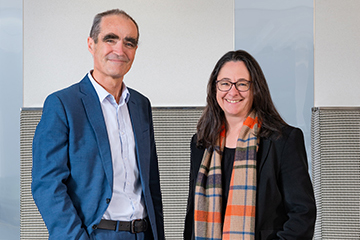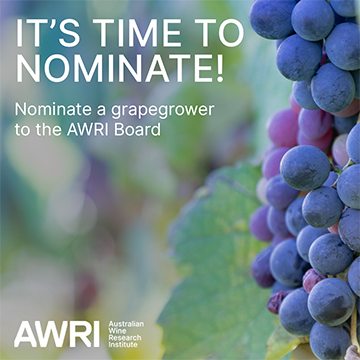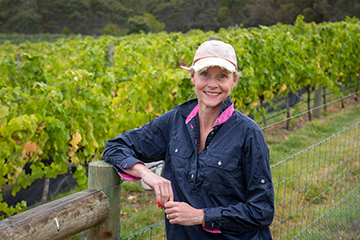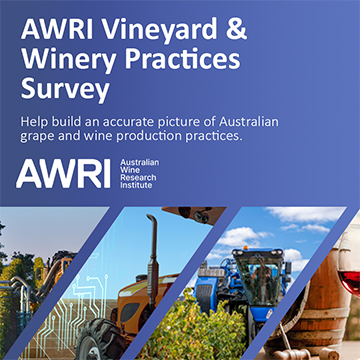27 October 2022
Very wet weather over the spring period has affected many Australian grapegrowing regions. Conditions have been conducive to the development of fungal diseases and symptoms of downy mildew infection of grapevines have been reported. The forecast is for this weather pattern to remain until the end of the year and it is important to take action now to avoid major crop loss. This eBulletin provides a fresh reminder of some strategies that can help reduce the risk and severity of fungal infection in high disease pressure years.
Be prepared to do more than usual
As weather affects when sprays can be applied, this season you should take every opportunity to get a spray on when you can. In wet seasons grapevines grow vigorously and the intervals between sprays must be shortened. A seven-day interval between sprays is sometimes necessary to protect rapidly emerging new growth. This might not be possible for everyone as you may be constrained by factors including restricted block access due to waterlogging, capacity of machinery to cover the vineyard area in a short time and access to chemical control options.
Prevention of disease is better than a cure in the current wet conditions. Planning to delay sprays until after an infection event may be viable for downy mildew in a dry year, but when disease pressure is very high you need to get protectants on early. There is always high demand for fungicides in wet years, so where possible keep a supply of chemicals on-hand. Almost all the registered products for downy mildew are protectants. Do not use these products on an active downy infection as this can lead to resistance, which may result in the loss of the product in the future.
For more information on registered agrochemicals refer to the Dog Book. Ask your supplier about what products are available and their attributes because products vary in their ability to function during extended wet weather periods. It’s important to use the product best suited to the conditions and this may be different from what you would use in dry years.
Communication with your winery or grape purchaser about your circumstances and your plan for controlling disease this season may provide options you had not considered. It will also enable a discussion about chemical options that are restricted for use in the Dog Book. The AWRI website has information about the use of phosphorous acid, but contact your winery or grape purchaser before using this product, because some export markets have a low tolerance to residues.
Tips for best-practice disease control
Good spray coverage is critical and failure to hit the target is the main reason for poor disease control. Test your spray coverage using water sensitive papers. Once your equipment is well set up, ensure you are putting out the right chemical rate and are not underdosing.
If you have had a downy mildew infection event and are using a metalaxyl or metalaxyl-M (group 4) for curative control, then a second group 4 spray on a 7–10-day interval is required. Use of a follow-up option from groups 40, 45, 21, 49 or 11 (assuming sensitivity remains) prior to the next period of infection is warranted to ensure the infection is controlled.
Shoot thinning, bunch thinning, leaf removal and carefully timed trimming may be necessary in a high-vigour year to open the canopy to light and air. This improves canopy drying time after rainfall and assists in spray penetration and chemical deposition in otherwise hard-to-reach areas. Vineyard floor management, such as keeping mid-rows low to support airflow and canopy drying, is another strategy to put in place. In addition, if a neighbour has made the decision to ‘rest’ their block, spraying a few boundary rows of theirs may help reduce disease pressure from those vines.
Be prepared to make tough decisions
When resources and time are constrained, it may be necessary to prioritise blocks. This means identifying your most profitable blocks and focusing on getting a healthy crop off those blocks. Spreading your resources too thinly in a high-pressure year may result in no suitable fruit being produced. If some areas of a block have become dangerous to access due to the conditions, make the decision early to sacrifice that fruit and focus your attention on those areas that can be safely managed.
Don’t forget the other diseases
Downy mildew oil spots will be top of mind for many, but powdery mildew and Botrytis are also a threat to yield and fruit quality. Powdery mildew is a risk when conditions are cloudy and humidity is high and this disease can grow rapidly. The typical week 2, week 4, week 6 spray program is not adequate in seasons like this one and protectants for powdery mildew should go out with all downy sprays. Controlling for downy and powdery will help manage Botrytis, and cultural practices that open up the canopy will be beneficial. Botrytis spore load will be high leading into and throughout flowering periods. If you have a budget for Botrytis sprays, flowering and pre-bunch closure are recognised as the critical growth stages. Removing the trash from inside and around developing bunches post-flowering takes away a source of Botrytis inoculum and alters the bunch environment for improved airflow and bunch drying. This strategy typically involves a harvester or blower, so planning and preparation are necessary.
Availability of metalaxyl and metalaxyl-M products
The metalaxyl and metalaxyl-M products registered for viticulture are currently in short supply. A permit has been sought from the APVMA to allow the use of alternative metalaxyl (-M) products that do not have grapes listed on the label. This process is undertaken in consultation with the agrochemical manufacturers to ensure that the products on the permit are suitable for the proposed use and there is stock available. The permit will detail which products are approved for off-label use and the conditions for their use. One important requirement is that they are tank mixed with a registered downy mildew protectant fungicide. It is anticipated that this permit will be received within the next one to two weeks. Some metalaxyl (-M) products are formulated for soil application and the suppliers of these products do not recommend their use as foliar sprays on wine grapes and they should not be used.
Don’t forget to look after yourself and your mates
These are difficult times and many are finding the going tough. Check on your mates and if you are in a difficult spot, it is important to talk about it. There is help available in your local community and from these organisations: Beyond Blue, Lifeline, Headspace, R U OK?, Black Dog Institute.
Additional resources on fungal diseases
- WA Department of Primary Industries and Regional Development’s information on downy mildew
- AWRI downy mildew update, November 2021
- The AWRI’s resources on downy mildew
- The AWRI’s resources on powdery mildew
- The AWRI’s resources on Botrytis
- Wine Australia’s resources on downy mildew
- Wine Australia’s resources on powdery mildew
- Wine Australia’s resources on Botrytis
- Control strategies for downy mildew and Botrytis (AWRI webinar 9 November 2018)
Acknowledgements
Liz Riley (Vitibit), Kerry DeGaris (Treasury Wine Estates), Warren Birchmore (Accolade Wines), Philip Deverell (Pernod Ricard Winemakers) and Scott Paton (Nutrien Ag Solutions) are thanked for their contributions to this eBulletin.
For more information or assistance, please contact the AWRI helpdesk on
08 8313 6600 or helpdesk@awri.com.au.









